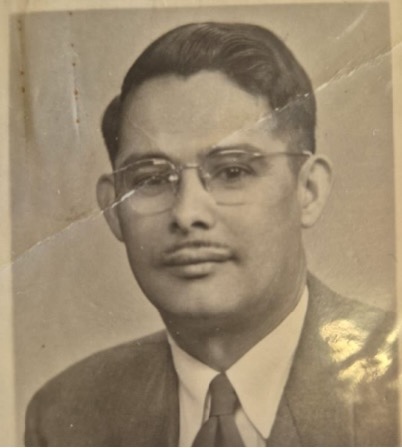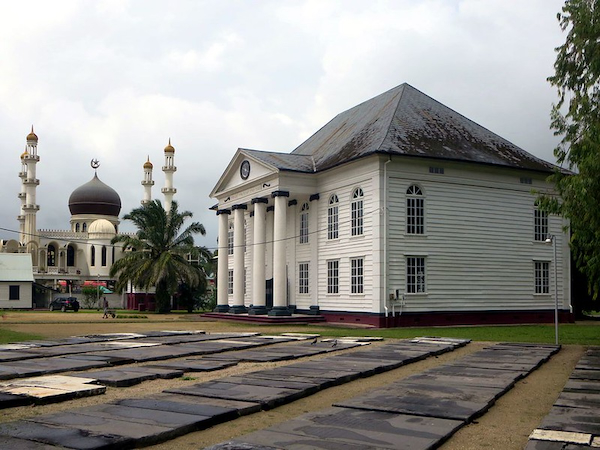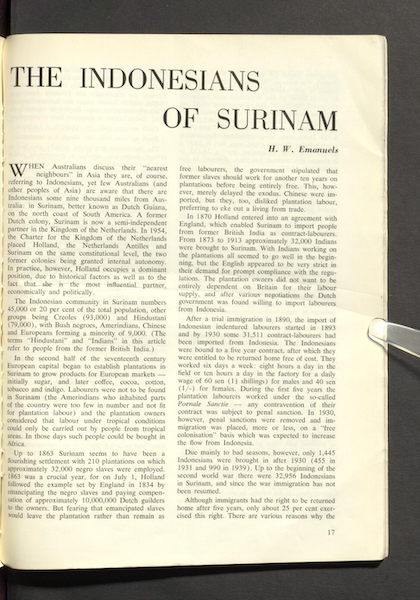More than six decades after being inspired as an undergraduate in Sydney, Ron Witton retraces his Indonesian language teacher's journey back to Suriname
I first heard about Suriname in 1962 when my Indonesian language lecturer, Hedwich Emanuels, known to us from day one as ‘Pak Emanuels’, told us he was from there. Like my fellow University of Sydney students, I had no idea where that place might be. A quick trip to the library to find an atlas (no smart phones in those far-off days) provided me with adequate geographical knowledge.

I learnt that Suriname, a small country on the northern coast of South America, gained its independence in 1975. It was formerly known as Dutch Guiana and is sandwiched between French Guiana (still a French possession), and Guyana (which gained its independence in 1966). The names ‘Suriname’ and ‘Guiana/Guyana’ were both derived from names used by the native people for the north coast of South America. Originally colonised by the British in 1650, Suriname was exchanged by the British in 1667 for the Dutch colony of New Amsterdam. From then on Suriname was a Dutch colony and the British changed the name of New Amsterdam to New York.
Further research in the library informed me that, from the seventeenth to the nineteenth century, more than 200,000 African slaves were brought by the Dutch West India Company to Suriname to work on the coffee, cocoa, sugar cane and cotton plantations. The particularly brutal conditions of the slave colony led to repeated slave revolts. Those that managed to escape fled to the jungles and often lived with the native Arawak and Carib tribes and became known as the Maroons. Following the abolition of slavery in 1863, the plantation owners, desperate for labour, arranged for the British Indian colonial government to send some 35,000 Hindu Indian contract labourers. However, the British government became concerned about the oppressive conditions under which the Indian contract labourers were forced to work, and so the Dutch government turned to their own colony of the Dutch East Indies (present day Indonesia) and contracted approximately 33,000 Javanese as plantation labourers. The mid 1800’s also saw the arrival of some 2,500 contract Chinese labourers.
Given the vast distances involved and sparse shipping, there was very little return migration by Africans, Indians, Chinese or Javanese. As a result, Suriname is now a thoroughly multicultural society made up of descendants of indigenous native peoples, African slaves, Dutch and other Europeans, Javanese, Chinese and Indian contract labourers, as well as immigrants from neighbouring South American countries. At one stage the country was also home to the world’s largest Jewish community. This resulted from a decision in 1639 by the English colonial government of Suriname to allow increasing numbers of Spanish and Portuguese Jews from the Netherlands, Portugal and Italy to settle there. They were later joined by Jews from elsewhere, but after World War II their numbers declined substantially. The generally harmonious nature of Suriname society is reflected in Paramaribo, the capital, where the country’s largest synagogue sits beside its largest mosque.
Discovering a diaspora
Learning from Pak Emanuels about Javanese living far away from their homeland inspired me, in my later travels, to find other expatriate Indonesian communities. Such communities are often referred to as ‘Malays’ because they spoke Malay in colonial times. The Malay language later became the basis of Bahasa Indonesia, Indonesia’s national language.

I have visited the Cocos (Keeling) Islands, and Christmas Island – both Australian territories in the Indian Ocean where people were imported from Java to work on plantations. These workers settled there, and to this day you can speak Indonesian/Malay at the local post office. Queensland was also home to many Indonesian contract labourers in the latter half of the nineteenth century where they worked in cane fields, and many Indonesians were recruited to Western Australia to work in the pearl-diving industry. Most of these Indonesians working and living in Australia were sent back to Indonesia when the White Australia policy was introduced at Federation.
In the Second World War, Australia was home to a several hundred Indonesian and Surinamese soldiers in the Dutch colonial army who were brought here by the Dutch when the Japanese invaded the Dutch East Indies. They were not allowed to fight in Europe due to the objections of the South Africans to serving alongside non-white soldiers. They were held in Casino, NSW, in a camp handed over to the Dutch government-in-exile which named it Camp Victory. They were very poorly treated by their Dutch commanders and were denied medical care, social services and paid in virtually worthless Javanese Invasion Money. Due to the racist ideology of their Dutch officers, they were forbidden to visit the town of Casino and were prevented from mixing with the local population. After their training was complete, they were then moved north to Queensland before participating in the Pacific War in 1944 and 1945.
The Dutch also brought to Australia Indonesians who had been imprisoned because of their anti-colonial activities. Their situation here as political prisoners held by the Dutch, became known to the Australian Labor-led government who demanded their release. They later became crucial to publicising the Indonesian declaration of Independence on 17 August 1945. They were joined in their anti-colonial activities by the Indonesian and Surinamese crews of Dutch ships in Australian ports and, together with Australian unions, prevented Dutch ships from leaving Australian ports to join the returning Dutch who attempted to suppress the Indonesian revolution.
I have travelled to Sri Lanka where Malays/Indonesians number some 40,000. The earliest came there in 200 BC as part of the Austronesian expansion from maritime southeast Asia. This expansion accelerated after 1640 when both Sri Lanka and Indonesia were Dutch colonies. Then, in 1796 when Sri Lanka was taken over by the British, Malays arrived from the British colony of Malaya.
In Cuba, I met a small community made up of Indonesians who in 1965 had been studying in socialist countries, so were deemed by the Suharto government to be communist sympathisers, making it too dangerous to return home. They sought refuge in Cuba and have lived there ever since. Their Indonesian citizenship was restored in 2000 by Indonesia’s progressive president, Abdurrahman Wahid.
The large Cape Town ‘Malay’ community has so far remained beyond my reach despite the fact I have been fascinated by it. Cape Town was established by the Dutch in 1652 as a way station for ships sailing to and from the Dutch East Indies. It was controlled from Batavia, and many Indonesians were brought there both as slaves and household staff. Many of South Africa’s ‘Coloured’ population are descendants of these Indonesians and speak Afrikaans. My fascination with this expatriate Indonesian community stems from having idly leafed through an Afrikaans dictionary that I’d found, by chance, on a table in the University of Wollongong library. I was astonished to find many ‘Malay’ words in Afrikaans. As a result, I wrote a paper, and as a result I continue to be contacted by South African linguists interested in this connection.
Searching for Pak Emanuels
While the Indonesian diaspora has continued to fascinate me since my first class with Pak Emanuels in 1962, it took me some 62 years before I managed to visit Suriname. My trip there last May was not only to see where Pak Emanuels hailed from, but also to get to know how a Javanese society had survived so far from ‘home’. I prepared for the journey by reading about the Javanese society of Suriname, including research by Pamela Allen.
We were warmly received at Suriname’s National Archives, the Java Suriname Cultural Centre, and the Indonesian Embassy. Everyone we met was fascinated to hear of the way that Pak Emanuels had influenced the development of Indonesian language studies in Australia.
We were interviewed by Audry-Roletti Wajwakana, a journalist from a major Paramaribo newspaper, De Ware Tijd, whose article, published after we returned to Australia, told the story of Pak Emanuels’ substantial contribution to Indonesian language learning and teaching in Australia, and reported on my quest to learn about his homeland. As a result of the publication of her article, we were subsequently contacted by Pak Emanuels’ relatives in Suriname and in the Netherlands. They too were pleased to learn about his influence on Indonesian language learning and told us much about the warm regard with which he was held in their families.
What became clear from these contacts, as well as from my readings and discussions with people I met in Suriname, is that close ties between Suriname and the Netherlands – and to a lesser extent Indonesia – continue for Surinamese families due to the way their lives had crisscrossed the globe. There is no way better to illustrate this than to examine the trajectory of Pak Emanuels’ life.
A life lived across cultures
Pak Emanuels was born in Suriname on 20 August 1916, of Javanese parents who married after he was born. His mother’s name was Adawardina, the daughter of Ha-Tjaw and Ardawatie. His birth name was Hedwich Winand Ha-Sjaw. His father, Radjiman Soetodrono, born in Java in 1893, and had accompanied his parents to Suriname in 1900. When the marriage of Hedwich’s parents was recognised, his family name was changed to Radjiman, as was also the case for his three brothers, Michiel, August and Iwan, and his two sisters, Jacqueline and Alice.
When his father died in 1924, his mother married again and had three daughters, Edith, Nita and Ursie, who were Hedwich’s half-sisters. Their family name was Haakmat, the name of the man their mother married. However, in the meantime, Hedwich had grown close to the family of James Emanuels and Jacqueline Taytelbaum, and was in effect adopted by them. The multicultural nature of Suriname society is also reflected in the family of James Emanuels: his father was Dutch and his mother was Creole, while Jacqueline Taytelbaum had a Jewish father and a Creole mother. Creole is a term typically used in Suriname for people of African-mixed descent.
In 1928, when James Emanuels and his family was sent to Bandung, Java, to set up government schools, Hedwich went with them. In 1937 he took on the family name of Emanuels. In 1941, Hedwich married Mary Siregar and they had two children.
James Emanuels and his family returned to Suriname in 1950. Hedwich remained in Java with his family. From 1939 to 1942, he worked as a customs officer in the Dutch East Indies government and later in private business.
In 1947 he gained a Teaching Certificate in Bahasa Indonesia in Batavia (Jakarta), providing him with a qualification necessary to embark on the professional life he was destined to pursue. Hedwich and his family travelled to Holland and, from 1948 to 1954, he worked as a private tutor in Indonesian Law to students at Leiden University. From 1954 until 1961, Hedwich was Assistant and then Head Assistant in Malay and Indonesian Language and Literature at Leiden University.
In Leiden he also studied and in 1953 gained a master’s degree in law under Professor A. Teeuw. He combined his linguistic knowledge of Indonesian/Malay to examine classical manuscripts that dealt with customary (adat) law. This work resulted in a scholarly publication by the prestigious journal of the Royal Netherlands Institute of Southeast Asian and Caribbean Studies. In 1953 he was one of only two people to hold an Official Government Translator’s Certificate for Bahasa Indonesia and Dutch. He then enrolled in Leiden University’s Ph.D. program under Professor Teeuw and began an historical study of Malay legal codes by making use of little studied Malay manuscripts in the university’s manuscript collection.
In October 1961, Hedwich arrived in Australia with his family to take up a lectureship in Indonesian and Malayan Studies at the University of Sydney. He had travelled to Australia via England where he taught Indonesian to employees of Standard Vacuum Oil Company, which had considerable investments in Indonesia. This also gave him an opportunity to study Malay manuscript collections held in London.
He later wrote a seminal article, ‘The Undang-Undang Melaka (The Malacca Laws)’, for the Journal of the Oriental Society of Australia (Vol 2 No. 2, June 1964). Recognition of his scholarly research resulted in invitations to give guest lectures at universities in Sweden and Denmark, invitations he was never able to take up given his heavy teaching load at the University of Sydney. In 1965 he was invited to take up a lectureship at the School of Oriental and African Studies, University of London, an invitation he also eventually declined.
What is clear is that while he had been recognised as a legal scholar of considerable potential, he had also developed skills as a language teacher that caused him to be in demand and became the hallmark of his academic career. In Holland he had already published several articles on teaching Indonesian including ‘Selamat Udjian’ (Good Luck in your Exams) and ‘Tjakap Karena Berani’ (Fluency through Bravery), and his commitment to spreading his innovative ideas on language teaching continued in Australia. In November 1964 the NSW branch of the Australia Indonesia Association published his article ‘Some aspects of the teaching of Bahasa Indonesia in NSW High Schools’, in their Bulletin, and the University of NSW published his Bahasa Indonesia Sehari-hari [Everyday Indonesian]- spoken Indonesian, Part 2, a course of 20 lectures. Of lasting significance is the book he coauthored with Vern Turner, Indonesian for Schools.
Pak Emanuels finally managed to return to the country of his birth for a short visit in 1959 and wrote an article for the journal Hemisphere entitled ‘The Indonesians of Surinam’ (December 1963).

His death in 1966 was met with profound sadness by his colleagues and his former students. His engaging and effective teaching principles had become the basis of their own professional development.
I found my visit to Suriname to be a very moving experience. It reminded me of the role Suriname played, through Pak Emanuels, in my life-long immersion in Indonesian language, history and culture. Somewhat ironically, however, I found virtually no evidence of Bahasa Indonesia, Indonesia’s national language, being spoken or even understood by the descendants of the Javanese brought to Suriname as contract labourers. What is spoken is a local version of Javanese that has evolved in Suriname and is largely derived from ngoko, the vernacular or informal register of Javanese used between friends and close relatives. Absent is kromo, the form of Javanese typically used by persons of lower social status when speaking to those of a higher status. Given that most Javanese in Suriname, like the rest of Suriname’s multicultural society, are also familiar with Sranan Tongo, a widely used local Creole language, Suriname Javanese includes much local vocabulary.
Dutch is Suriname’s national language and has had a continuing linguistic influence on Suriname’s Javanese population, unlike in Indonesia where the influence of Dutch ceased when Indonesia gained its independence. The vast distance between Suriname and Indonesia has meant that the influence of Indonesia on Suriname’s population is minor compared to the influence of the Netherlands where many of Suriname’s population have relatives. Indeed, it was noticeable that those who contacted us about Pak Emanuels came from both Suriname and the Netherlands, and that in modern times there exists a constant flow of population between these two countries.
There have been vast distances travelled by Suriname’s Javanese population between Suriname, Indonesia and the Netherlands. When one adds in Australia, the distance travelled in Pak Emanuels’ life can really be appreciated. Immigrant families have created vast networks spanning the globe, and relatives constantly travel them to maintain kinship ties. The relationships that are sustained via these networks continue to enrich the societies where families, such as that of Pak Emanuels, have settled.
Ron Witton (rwitton44@gmail.com) gained his BA and MA in Indonesian and Malayan Studies at the University of Sydney and his PhD from Cornell University. He has taught in universities in Australia, Indonesia and Fiji. He still works as an Indonesian and Malay translator and interpreter.










